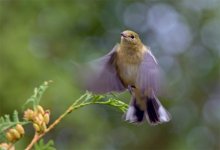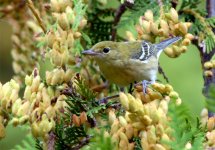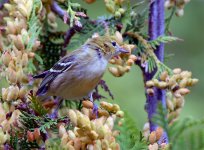-
Welcome to BirdForum, the internet's largest birding community with thousands of members from all over the world. The forums are dedicated to wild birds, birding, binoculars and equipment and all that goes with it.
Please register for an account to take part in the discussions in the forum, post your pictures in the gallery and more.
You are using an out of date browser. It may not display this or other websites correctly.
You should upgrade or use an alternative browser.
You should upgrade or use an alternative browser.
another mystery (1 Viewer)
- Thread starter raymondjbarlow
- Start date
More options
Who Replied?Chris Benesh
So much work, so little time...so let's go birding
Hey Guys,danehower said:I don't know - I am looking at my guides , and I am thinking immature Yellow warbler ...? Does that work ? hmmm.... Looking foward to more responses .
This is a tricky one. Dave, check out the tail of this bird and notice that it is rather blackish with big white tail spots. This pattern rules out a Yellow Warbler (though it is a Dendroica warbler). The actual pattern is helpful in ruling out a couple of candidates. Notice too that there is a hint of white wing bars on the birds left wing, also wrong for Yellow Warbler. Lastly, pay close attention to the color of the underparts, somewhat pale yellow-ochraceous, and notice that the color extends all the way down to include the undertail coverts. Those features may get you to the correct answer with a bit of sleuthing. Remember, we're dealing with a "confusing" fall warbler.
Chris
raymondjbarlow
Well-known member
Chris Benesh said:Hey Guys,
This is a tricky one. Dave, check out the tail of this bird and notice that it is rather blackish with big white tail spots. This pattern rules out a Yellow Warbler (though it is a Dendroica warbler). The actual pattern is helpful in ruling out a couple of candidates. Notice too that there is a hint of white wing bars on the birds left wing, also wrong for Yellow Warbler. Lastly, pay close attention to the color of the underparts, somewhat pale yellow-ochraceous, and notice that the color extends all the way down to include the undertail coverts. Those features may get you to the correct answer with a bit of sleuthing. Remember, we're dealing with a "confusing" fall warbler.
Chris
thanks for your efforts so far everyone.. I am sure it's just a yellow warbler.. here is another shot of the same bird, not a good shot, but one that will help you ID this bird.
sorry for being a pain in da but.
Attachments
Chris Benesh
So much work, so little time...so let's go birding
So Ray,raymondjbarlow said:thanks for your efforts so far everyone.. I am sure it's just a yellow warbler.. here is another shot of the same bird, not a good shot, but one that will help you ID this bird.
sorry for being a pain in da but.
Your not being a pain and hopefully you won't think me one, but why do you think this is a Yellow Warbler? I was trying to give away some clues as to what I think its real identity is, but so far, no one has ventured another guess. The second image shows more streaking on the sides of the breast, and doesn't show the undertail coverts that were so clearly buff in the first picture. I'm still sticking with my initial hunch, however. Anyway, for those who don't want to guess, here are two links to what I think this warbler really is:
http://tinyurl.com/rr2u5
http://tinyurl.com/s8mbm
Let me know if anyone agrees. Maybe I'm just crazy.
Chris
cavan wood
Well-known member
I'm getting quite an education on certain Dendroica warblers this past week, especially with regards to pine, bay-br., and blackpoll. I just wish the ones in the bush would sit still long enough for me to check all the legs, back streaks, side streaks, rumps, and undertail coverts.
None of my guides show or mention the white tail spots on bay-breasted. Besides magnolia, which other Dendroica's show tail spots?
Scott
None of my guides show or mention the white tail spots on bay-breasted. Besides magnolia, which other Dendroica's show tail spots?
Scott
Jane Turner
Well-known member
Top of the head - Parula, Yellow (wellow ones) Chestnut -sided, Black-throated Blue, Palm, Pine, Blackpoll ....Yellow-rumped..... in fact the more I think about it its most of them!
Chris Benesh
So much work, so little time...so let's go birding
Hey Scott,cavan wood said:None of my guides show or mention the white tail spots on bay-breasted. Besides magnolia, which other Dendroica's show tail spots?
I would guess that you have got a copy of Sibley as one of your primary guides. If so, check out the flight shots of the various warblers, and you will see that a great majority of species possess some amount of white in the tail. These flight views are a good way to see the differences shown by various species. For some, the white patches are relatively restricted to the corners of the tail, in others, the entire outer tail feathers are essentially white. Among the Dendroica, Magnolia has a rather unique pattern in that the white band is in the middle of the individual tail feathers. Yellow Warbler differs from the other Dendroica in having yellow, rather than white tail spots, thus eliminating it from consideration in Ray's example. Another great reference for tail patterns in found in the last two plates of the Dunn & Garrett Petersons Warblers Guide. Remember too that one needs to see the tail from below to accurately determine the pattern of white in the tail, unless the bird is spreading its tail for some reason.
As Jane suggests too, white patterns in the tail are not restricted to the genus Dendroica, but are found in several other genera as well.
Chris
cavan wood
Well-known member
Thanks Chris and Jane (and Raymond for the thread). I have three field guides, all published before 1984. I asked for Sibley for Christmas last year...got ties instead (Just joking)...but looks like I'll have to take matters into my own hand.
Scott
Scott
raymondjbarlow
Well-known member
thanks everyone for the very interesting and informative comments, you all are fine poeple, and I do enjoy this forum very much. I am a complete rookie when it comes to birding, and very un-educated when it comes to photography, but I love to learn, and this is fun learning.
attached is one last shot.
Thanks again!
attached is one last shot.
Thanks again!
Attachments
Similar threads
- Replies
- 0
- Views
- 406
- Replies
- 2
- Views
- 635
Users who are viewing this thread
Total: 2 (members: 0, guests: 2)






